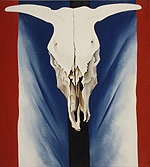 |
Georgia O'Keefe,Red, White, and Blue, 1931. Oil on canvas; H. 39-7/8, W. 35-7/8 in. (101.3 x 91.1 cm) Alfred Stieglitz Collection, 1952 |
|
Georgia O'Keefe |
 |
Georgia O'Keefe,Red, White, and Blue, 1931. Oil on canvas; H. 39-7/8, W. 35-7/8 in. (101.3 x 91.1 cm) Alfred Stieglitz Collection, 1952 |
The following was copied from:
Arnason, H.H., Marla F. Prather. History of Modern Art: Painting, Sculpture, Architecture, Photography. 4th. ed. New York: Abrams, 1998.
The last exhibition at 291, held in 1917, was the first solo show of work by Georgia O'Keefe (1887-1986). O'Keefe differed from most of the other American pioneers of modernism in that she trained in Europe. Hartley said she was simply "modern by instinct," although she had been exposed, especially through exhibitions at 291, to the work of the major European modernists. The biomorphic, Kandinsky-like abstractions in charcoal that she made in 1915-16 so impressed Stieglitz that he soon gave her an exhibition. The two artists fell in love and married in 1924. Before he put away his camera for good in 1937, Stieglitz made more than 300 photographs of O'Keefe, contributing to her almost cult status in t twentieth-century American art.
Whether her subjects were New York skyscrapers, enormously enlarged details of flowers, bleached cow skulls, or adobe churches, they have become icons of American art. Her paintings involve such economy of detail and such skillful distillation of her subject, that, however naturalistically precise, they somehow become works of abstraction. Alternatively, her abstractions have such tangible presence that they suggest forms in nature. Music--Pink and Blue, II is a breathtaking study in chromatic relationships and organic form. The title suggests the lingering influence of Kandinsky's equation of color with music and, ultimately, with emotion. Typically ambivalent, the forms resemble an enlarged close-up of the flowers O'Keefe painted in the 1920s, although some have seen them as sexually charged. He artist rejected such readings of her imagery, and partly in response to such interpretations, her work became more overtly representational in the 1920s, as in her tightly rendered views of New York skyscrapers made from the window of her Manhattan apartment. In 1929 O'Keefe visited New Mexico for the first time and thereafter divided her time between New York and the Southwest, settling permanently in New Mexico in 1949. The desert motifs she painted there count among her best-known images.
Arnason, H.H., Marla F. Prather. History of Modern Art: Painting, Sculpture, Architecture, Photography. 4th. ed. New York: Abrams, 1998.
Armory Show Web Site
Linda M. Larson. All rights reserved.
Revised: 29 Nov 2000 14:30:28 -0500 .